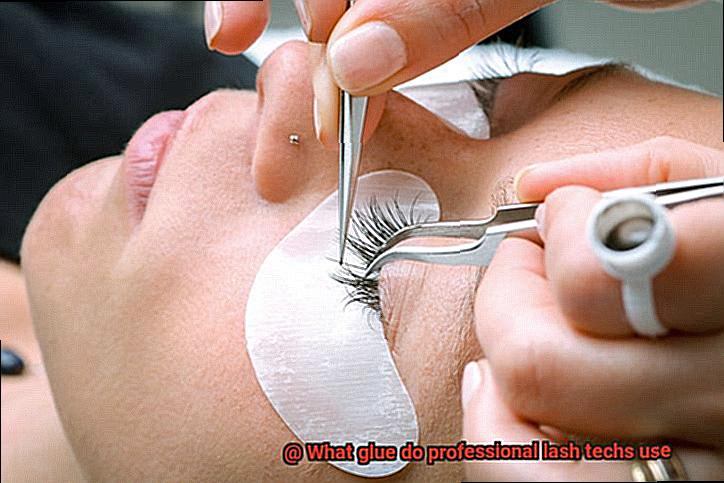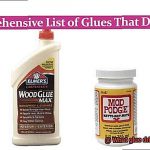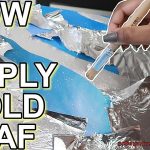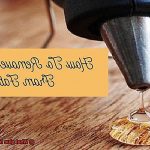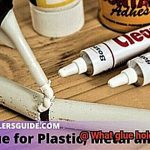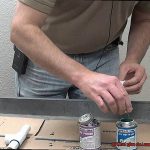Are you a fan of luscious lashes that make your eyes pop? If so, you may have tried eyelash extensions. But did you know that the glue used by professional lash techs is just as important as the extensions themselves?
Without the right adhesive, your extensions won’t last long and could cause irritation or even allergic reactions. That’s why top-notch lash techs use specially formulated adhesives that are safe for use around the delicate eye area and suitable for different skin types.
The most popular adhesive among lash techs is cyanoacrylate-based, which creates an optimal hold without compromising on safety. This type of adhesive dries quickly and lasts for several weeks, ensuring your extensions stay put until it’s time for a fill.
To achieve stunning results and prevent premature shedding, professional lash techs always go for high-quality adhesives that create a strong bond between natural lashes and extensions. Whether you’re a lash tech or someone looking to get gorgeous lashes, knowing what glue professionals use can help you achieve the look you desire.
Types of Glue Used by Professional Lash Techs
Contents
Lash extensions are a popular beauty trend that requires the use of high-quality glue to ensure a secure and long-lasting bond. Professional lash techs use various types of glue, each with its own unique properties and strengths. Here are five sub-sections that explore the different types of glue used by professional lash techs and their respective properties:
Cyanoacrylate glue
This is the most commonly used adhesive by professional lash techs because of its fast-drying and strong hold properties. It creates a seamless bond between the natural lashes and extensions, making it ideal for clients who live an active lifestyle or have oily skin. However, cyanoacrylate glue can cause irritation or allergic reactions for some people.
Formaldehyde-free glue
This type of glue is free from toxic chemicals that can cause discomfort or irritation, making it a great option for clients with sensitive eyes or allergies. It’s also gentle on the natural lashes, ensuring that they won’t be damaged during the application process.
Medical-grade glue
This adhesive is specifically designed to be gentle on sensitive skin and won’t cause irritation or discomfort. It’s typically used for clients who have undergone chemotherapy or have other medical conditions that affect their skin or scalp.
Rubber-based glue
Rubber-based glues are becoming more popular among professional lash techs because they are less likely to cause irritation or allergic reactions than other types of adhesives. They also have a flexible hold, which allows the extensions to move more naturally with the client’s natural lashes.
Colorful glue
Some lash artists use colored glues to create a unique look for their clients. These glues come in various colors like black, brown, and clear and work well with different types of lashes.
Aside from the type of glue, other factors like drying time, viscosity, and color should also be considered when choosing an adhesive. Some lash techs prefer a slower-drying glue to allow more time for adjustments during application, while others prefer a quicker-drying adhesive for faster appointments. Additionally, some glues have a thinner viscosity, which allows for more precise application, while others are thicker and work better for volume lash sets.
In conclusion, choosing the right glue is just as important as selecting the right lashes. Professional lash techs should have a deep understanding of the properties and strengths of different types of glue to recommend the best option for their clients.
Cyanoacrylate-Based Glue
If you’re looking for a reliable adhesive to achieve a stunning and enduring eyelash extension, then cyanoacrylate-based glue is the way to go. This type of glue is a top choice among lash techs because it provides a quick-drying and sturdy bond. Plus, it’s compatible with natural lashes and won’t cause any irritation or damage.
One of the most significant benefits of using cyanoacrylate-based glue is its fast-drying time. This allows lash techs to work efficiently without having to wait for the glue to dry before moving on to the next step. Additionally, this type of glue provides a strong and long-lasting hold, ensuring that the lashes stay in place.
However, not all cyanoacrylate-based glues are created equal. There are numerous formulations available on the market, each with its own set of strengths and weaknesses. It’s vital for lash techs to choose the right type of cyanoacrylate-based glue for their clients based on factors such as sensitivity, humidity levels, and desired retention time.
When using cyanoacrylate-based glue, proper application technique is crucial. Applying just the right amount of glue precisely will prevent any irritation or damage to the client’s eyes. It’s also important to be aware of any potential allergic reactions and take measures to minimize risk.
Medical-Grade Adhesive
Look no further than medical-grade adhesive for your eyelash extension needs.
Medical-grade adhesive is a gentle and safe glue that is widely used in the medical industry for wound closures and surgical procedures. Professional lash technicians also use this adhesive for eyelash extensions because it’s specifically formulated to be gentle on the sensitive skin around the eyes. Plus, its long-lasting hold ensures that your lash extensions stay in place for several weeks at a time.
But not all medical-grade adhesives are created equal. Some may be stronger or have longer drying times than others, which can affect the application process and overall results of lash extensions. To ensure optimal results, it’s crucial to choose a medical-grade adhesive that has been specifically designed and tested for lash extensions.
One of the most significant benefits of using medical-grade adhesive for lash extensions is its hypoallergenic properties. This means that it’s less likely to cause an allergic reaction or irritation in clients with sensitive skin or allergies. However, it’s still important to inform your lash technician of any allergies or sensitivities you may have to ensure they use the appropriate adhesive for you.
When getting lash extensions, it’s essential to follow proper application techniques and safety protocols to avoid any potential risks or complications. Your lash technician should also inform you of any potential side effects or risks associated with the use of adhesive, and provide instructions for proper aftercare.
Combination of Different Adhesives
If you’re looking to enhance the longevity and strength of your lash extensions, then combination adhesives might be just what you need. This popular technique involves mixing two or more different types of adhesives to create a customized formula that suits your specific needs.
One of the most common combinations is mixing a fast-drying adhesive with a slower-drying one. This technique helps to strike a balance between speed and longevity, making it perfect for clients who have oily skin or live in humid climates. By preventing premature lash shedding due to excess oil or moisture, this technique ensures that your lashes stay put for longer.
Another popular combination is mixing a low-fume adhesive with a high-strength one. This creates a formula that is both safe and durable, making it the ideal choice for clients who have sensitive eyes or allergies to certain chemicals commonly found in lash adhesives.
However, it’s important to note that combination adhesives should only be used by experienced professionals who know what they are doing. Improper mixing can result in weak or brittle bonds that can lead to lash damage or loss. So, if you’re thinking of trying this technique, make sure you go to someone who has a deep understanding of the different types of adhesives and how they interact with each other.
In addition, there are other combinations of adhesives that can provide unique benefits for clients. For example, combining a clear adhesive with a black one can create a natural-looking finish while still providing the dramatic effect of black lashes. Mixing a low-odor adhesive with a waterproof one can ensure that your lashes stay put even during water-based activities like swimming or showering.
Factors to Consider When Choosing an Adhesive
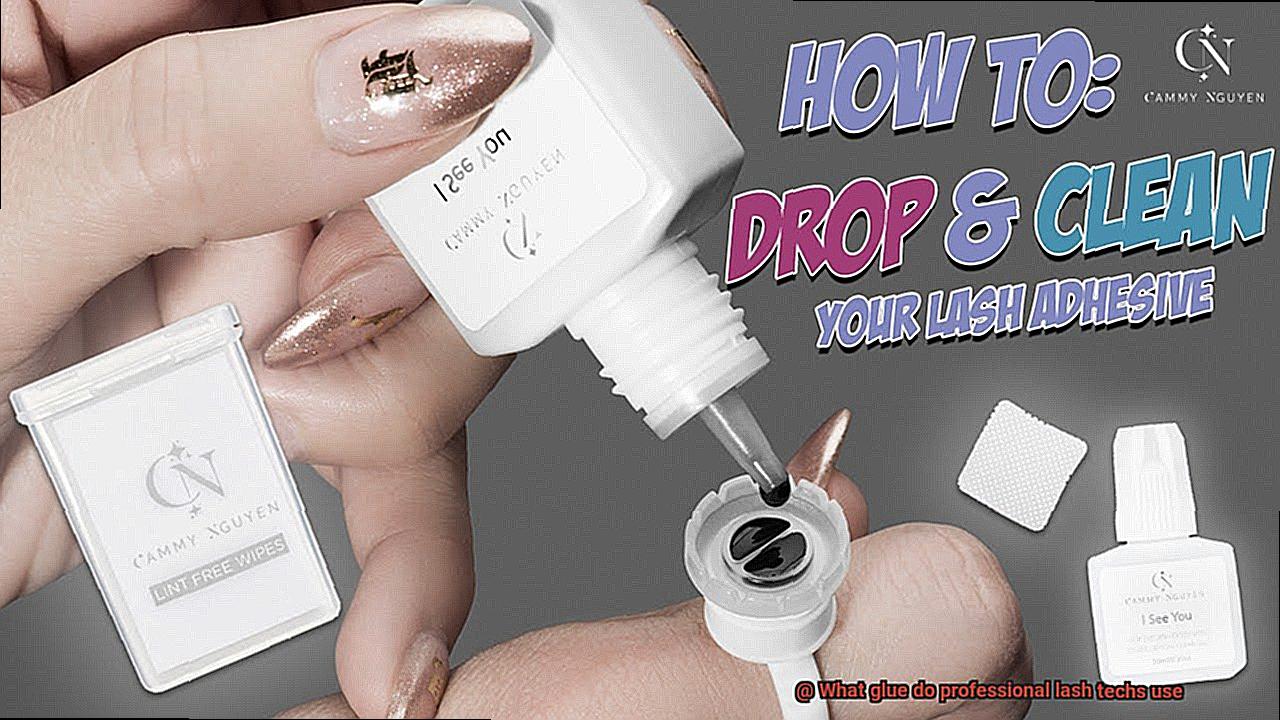
As a professional lash tech, you know that choosing the right adhesive for lash extensions is crucial to achieving a stunning and long-lasting result. With so many options available, it can be challenging to know where to start. Here are some essential factors to consider when selecting the perfect adhesive:
Bonding strength is the first and most critical factor. The adhesive must be strong enough to keep the extensions in place for several weeks while not damaging natural lashes. A weak adhesive could cause the extensions to fall off prematurely, while a too-strong adhesive could lead to breakage and damage.
Drying time is another essential consideration. You need an adhesive that dries quickly enough to work efficiently but not so fast that you don’t have sufficient time to correctly place the extension. Typically, drying times range from 1-3 seconds.
Viscosity or thickness of the adhesive is also important. A thicker adhesive is easier to control and less likely to run into clients’ eyes, but it may feel heavier on the lashes. A thinner adhesive can provide a more seamless and natural look, but it requires precision in application.
The ingredients used in the adhesive are critical to consider as well. Some clients may have allergies or sensitivities to certain ingredients, so it’s important to choose an adhesive that is hypoallergenic and free of harmful chemicals.
Lastly, proper storage and handling of the adhesive are critical factors. Adhesives must be stored in a cool, dry place and shaken well before each use. It’s also vital to replace adhesives every 4-6 weeks to ensure maximum effectiveness.
Quality of the Glue
First and foremost, let’s talk about bonding strength. The strength of the bond determines how long your lashes will last. However, a strong bond can also mean a greater risk of damage to your natural lashes if not applied properly. Professional lash techs opt for glues with medium to high bonding strength that are safe for their clients.
Next up is drying time. Quick-drying glues can be beneficial for both the lash tech and client, but there’s a fine line between drying too quickly and not allowing enough time for proper placement. Finding the perfect balance is key to achieving a smooth, clump-free application.
The consistency of the glue also plays a role in its quality. A thicker consistency may make it easier to work with and provide better control, but it can also lead to clumps or difficulty in spreading evenly. On the other hand, a thinner consistency may be more difficult to control but can provide a more natural look. Lash techs often experiment with different consistencies to find what works best for them and their clients.
Last but certainly not least, safety is always a top priority. Professional lash techs look for glues that are hypoallergenic and safe for sensitive eyes. Allergies or sensitivity issues can cause major discomfort or even damage, so using safe products is crucial.
Drying Time and Strength of Bonding
As a lash tech, you know that the perfect adhesive is the key to achieving stunning and long-lasting lash extensions. The two most important factors to consider when choosing an adhesive are the drying time and strength of bonding.
Drying time is critical in ensuring that you can work quickly and efficiently. Look for an adhesive with a quick drying time, preferably one that dries in 1-2 seconds. However, remember that humidity and temperature can affect drying time, so be aware of your working environment.
Strength of bonding is equally important. Different types of cyanoacrylate adhesives are available, each with its unique properties. Some are designed for stronger bonding, while others offer a more flexible hold. As a lash tech, it’s essential to assess your client’s natural lashes and choose the right adhesive for them.
For clients with thicker or heavier lashes, opt for an adhesive with stronger bonding properties. This ensures that their lashes stay in place and don’t fall out prematurely. For those with thinner or more delicate lashes, a more flexible hold will prevent their lashes from becoming too stiff or uncomfortable.
When assessing the strength of bonding in an adhesive, consider the ingredients. Many professional-grade adhesives contain additional ingredients such as rubber or plasticizers to enhance their bonding properties. These can make all the difference in ensuring your clients’ lashes stay put for as long as possible.
Hypoallergenic Properties
As professional lash techs, we all want to provide our clients with the best possible lash extension experience. But have you ever stopped to consider the importance of selecting adhesives with hypoallergenic properties? Let’s take a closer look.
Hypoallergenic properties are crucial when it comes to selecting glue for lash extensions. The main ingredient in lash extension glue, cyanoacrylate, is a fast-drying adhesive that can cause redness, itching, and swelling in some people. To minimize the risk of allergic reactions, many lash techs opt for hypoallergenic adhesives that contain lower levels of cyanoacrylate or alternative ingredients.
One popular alternative ingredient is medical-grade butyl cyanoacrylate, which is often used in surgical procedures and has been found to be less irritating to the skin. Formaldehyde-free and latex-free adhesives are also great options for clients who have allergies to these substances.
Here are some sub-topics to consider when selecting adhesives with hypoallergenic properties:
- Reduced Allergic Reactions: Choosing hypoallergenic adhesives ensures that clients won’t experience any allergic reactions that could result in discomfort or even worse, an infection. This is crucial for the safety and well-being of our clients.
- Medical-Grade Alternative Ingredients: Medical-grade butyl cyanoacrylate is an excellent alternative ingredient for clients with sensitive skin. It is less irritating than traditional cyanoacrylate adhesives and has been used safely in surgical procedures.
- Formaldehyde-Free and Latex-Free Adhesives: These adhesives are also great options for clients who have allergies to formaldehyde or latex. Using these types of adhesives helps ensure that clients won’t experience any adverse reactions during or after their lash extension procedure.
It’s important to note that even with hypoallergenic properties, there is still a risk of allergic reactions for some individuals. That’s why lash techs should always conduct a patch test on their clients before applying lash extensions to ensure there are no adverse reactions. Additionally, clients should inform their lash techs of any allergies or sensitivities they may have before the application process begins.
_QWq7FJEVz4″ >
Conclusion
In the world of lash extensions, glue is just as important as the lashes themselves. Professional lash techs rely on cyanoacrylate-based adhesives for their optimal hold and quick drying time. But there are also other types of glue available that offer unique properties and strengths.
When selecting an adhesive, it’s essential to consider factors such as bonding strength, drying time, viscosity or thickness, ingredients used, and proper storage and handling. Safety is also a top priority for lash techs who look for hypoallergenic and sensitive-eye-friendly options.
Knowing what glue professionals use can help you achieve the look you desire. Whether it’s cyanoacrylate-based glue or medical-grade adhesive or combination adhesives that enhance longevity and strength – there’s an option out there that suits your specific needs.
However, it’s crucial to note that proper application technique is vital when using any type of adhesive. Lash techs must understand the properties and strengths of different glues to recommend the best option for their clients.

